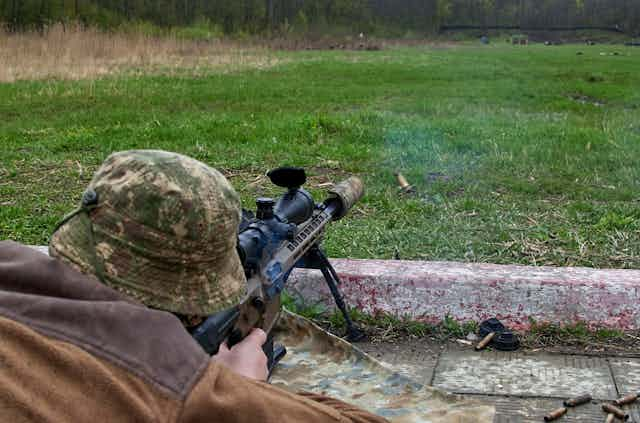After a long campaign of attritional warfare in the east of Ukraine over the winter months, things appear to be stirring in the south where there have been multiple reports of preparations for the long-awaited Ukrainian spring offensive.
The gradual arrival of the sophisticated military equipment promised by Kyiv’s western allies and the training of Ukrainian troops to use it will be the key to the timing of this anticipated push. Already there are reports that Ukrainian troops have established a bridgehead on the eastern bank of the Dnipro River in the south. This could be the precursor for a major push south towards Crimea.
Russia has spent most of April trading lives and equipment for modest territorial gains around Bakhmut, leaving their forces exhausted. Their own earlier winter offensive achieved little. Capability and morale are suffering, with key Russian figures including the CEO of the Wagner Group mercenary company, Yevgeny Prigozhin, calling for Russia to assume a defensive posture to solidify their hold on the territory they currently occupy.
Russian forces may be forced to dig in for the foreseeable future as Ukraine attempts to advance. While this would be the pragmatic thing to do, particularly in light of the building Ukrainian counteroffensive, it is politically unpalatable for Putin. The Russian leadership has struggled to recognise that they lack the resources for a major offensive of their own, and generals may face mounting political pressure to respond to Ukrainian advances and capture more territory. This is unlikely to go well.
Russia’s best chance of stopping further liberation of territory may now not be on the battlefield. Right now their best bet might be to attempt to force a stalemate through an agreement or ceasefire. China is providing Russia a lifeline through its proposed political settlement.
Around the world, there is growing support for an end to hostilities, particularly among those countries hit by rising costs and food insecurity brought on by the conflict. Developing countries are increasingly unwilling to speak out against Russia, instead calling for a diplomatic solution, though there is yet no clear picture of how this might unfold. Now that Ukraine has the initiative, a break in fighting to negotiate would give Russia time to rearm and regroup.

Russian strategy appears to be more about buying time and saving face rather than securing lasting peace. A negotiated stalemate would only last as long as it serves Russian interests. With time, Russia can solidify its hold on occupied territories and renovate its armed forces before reigniting the conflict on its terms. There is also the possibility that Putin anticipates that western support for Ukraine is not indefinite, and he needs only bide his time.
International support
It may be the case that tanks and equipment from donor nations provide a decisive edge to the Ukrainian counteroffensive. The provision of this high-end military equipment, including armoured vehicles, is one indication that the west, and the US in particular, would rather see this war end sooner rather than later.
The recent leak of a large cache of US intelligence reports has suggested that Washington initially only expected Ukraine to recapture a moderate amount of territory in the coming months, identifying supply issues as a significant problem. There are hopes that this issue is at least partially resolved, though some shortages still exist, exacerbated by hard fighting throughout the winter. Artillery shells and other munitions are in particularly short supply.
Yet, with a reported 12 new combat brigades ready to take the fight to the Russians, there is still a chance of a major breakthrough taking place.
The road south
At this stage, nothing is certain, however. Ukrainian officials remain tight-lipped about their immediate plan. If may be that the push across the Dnipro in the southern Kherson region is a feint to distract from a major push in the north-east. Ukraine has tricked the Russians before notably in the Kharkiv counteroffensive last autumn when pains were taken to disguise their intentions for a major assault on Russian forces. With the support of western intelligence, they will know exactly where to strike to maximise impact.
Kyiv knows it needs a dramatic victory to reassure western allies, some of whom are beginning to join China in advocating for a negotiated settlement which could result in Ukraine having to cede territory to Moscow. There is an element of Catch-22 at play here. The west wants reassurance that Ukraine can achieve a major military success, while Ukraine needs western arms and support to do so.
At the moment, there is no indication that Ukraine would accept any loss of territory whatever the circumstances. Kyiv’s stated conditions for an end to the conflict remain the same. Removing Russian presence from the country also remains significant from an international perspective – any other outcome would potentially encourage future aggression from other authoritarian regimes.
It is fair to say that the stakes are high in the coming weeks. With Russia eyeing a stalemate, a Ukrainian victory will send a powerful message – and, perhaps just as importantly, buy time.

